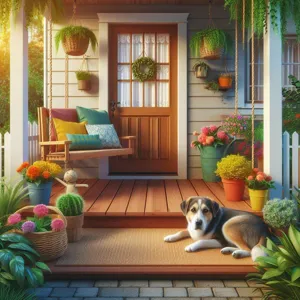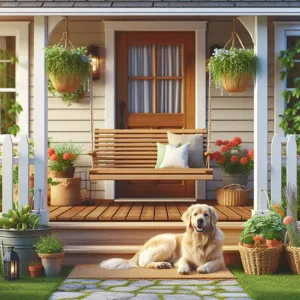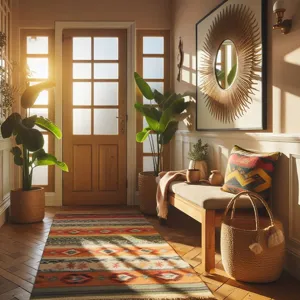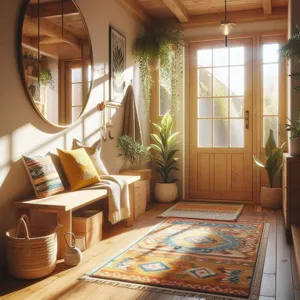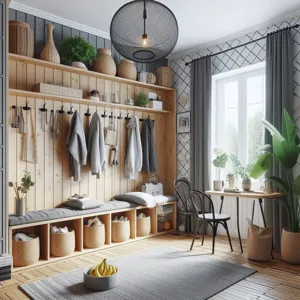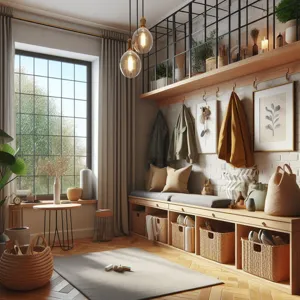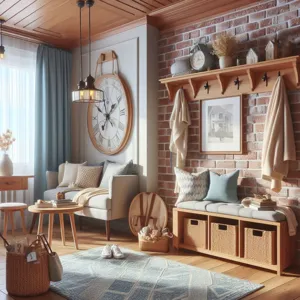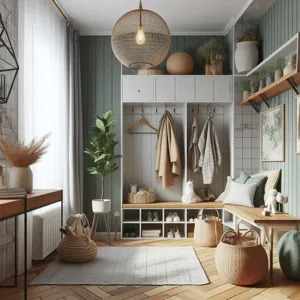Your entryway is the first impression guests have of your home, yet it often becomes a chaotic catch-all for shoes, bags, and outdoor gear.
A well-designed mudroom can transform this frequently overlooked space into a functional and stylish haven that not only organizes your belongings but also enhances your home’s aesthetic. Imagine a welcoming area where practicality meets design—complete with clever storage solutions, beautiful decor, and a sense of warmth that invites everyone in. In this blog post, we will explore practical tips and creative ideas to help you craft the perfect mudroom that balances functionality with style. From choosing the right furnishings to implementing smart organizational strategies, let’s turn your entryway into a serene and stylish space that sets the tone for the rest of your home!
1. Understanding the Purpose of a Mudroom

When it comes to home design, the mudroom often serves as an unsung hero—a transitional space that bridges the outdoors and the comfort of your living areas. Understanding the purpose of a mudroom is essential for maximizing its potential as both a functional and stylish component of your home.
At its core, a mudroom is designed to handle the mess that accompanies coming in from the outside world. It is the first line of defense against dirt, mud, and clutter. This space offers a dedicated area for dropping off shoes, coats, bags, and sporting gear, preventing the chaos that often spills into hallways and living rooms. By creating a designated spot for these items, you can maintain a cleaner, more organized home.
However, the mudroom’s purpose extends beyond mere functionality. It can also be a welcoming entryway that sets the tone for your home. Imagine stepping into a beautifully designed space that combines practicality with aesthetic appeal—a place where every item has its designated area, yet the overall ambiance invites warmth and charm. From built-in benches adorned with plush cushions to chic hooks for hanging jackets, the possibilities to enhance this space are endless.
Additionally, the mudroom can serve as a multi-functional area for various activities. Whether it’s a place for kids to store their backpacks after school, a pet station complete with food bowls and leashes, or a mini laundry zone for sorting clothes, the mudroom can adapt to your family’s unique needs. By understanding the true purpose of a mudroom, you can transform it into a stylish and efficient space that enhances your home’s overall design while making daily life a little easier.
2. Essential Features of a Functional Mudroom
Creating a mudroom that is both functional and stylish requires careful consideration of its essential features. At its core, a well-designed mudroom serves as a transitional space that bridges the outdoors and your home, helping to keep dirt and clutter at bay while providing a welcoming entry point. Here are some key elements to incorporate into your mudroom design:
**1. Adequate Storage Solutions:** A functional mudroom needs ample storage to accommodate shoes, coats, bags, and outdoor gear. Consider built-in benches with cubbies or baskets beneath for easy access to frequently-used items. Hooks or a wall-mounted rack can keep jackets and backpacks organized, while a dedicated shoe rack helps contain what could easily become a chaotic array of footwear.
**2. Durable Flooring:** With the constant traffic of muddy shoes and wet clothes, the flooring in your mudroom should be both durable and easy to clean. Opt for materials like tile, vinyl, or laminate that can withstand moisture and wear. Adding a colorful or patterned rug can provide a touch of style while also serving as a designated spot for wiping feet.
**3. Functional Lighting:** Proper lighting is crucial in a mudroom, especially if it lacks windows. Install overhead fixtures for general illumination and consider adding wall sconces or pendant lights for a warm, inviting ambiance. natural light can be a game-changer, so if possible, incorporate a window or a glass door to brighten the space and create a more open feel.
**4. Practical Work Surface:** If your mudroom doubles as a laundry area or pet space, a sturdy countertop can be invaluable. This surface provides a place for sorting mail, folding laundry, or grooming pets, enhancing the room’s functionality. Choose materials that are easy to wipe down and resistant to stains.
**5. Personal Touches:** Finally, don’t forget to infuse your mudroom with style that reflects your personality. Incorporate decorative elements like framed photos, artwork, or stylish storage bins to make the space feel welcoming. A fresh coat of paint in a cheerful color or wallpaper with fun patterns can elevate the overall aesthetic and make your mudroom a charming part of your home.
By thoughtfully integrating these essential features into your mudroom design, you’ll create a space that not only looks great but also enhances the functionality of your entryway, making daily routines smoother and more enjoyable.
3. Assessing Your Space: Layout and Design Considerations
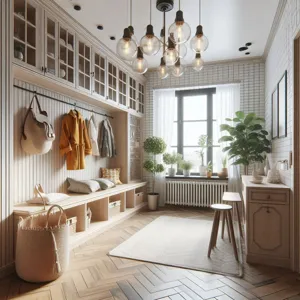
Before diving into decorating your mudroom, it’s essential to take a step back and assess the space you have available. The layout and design considerations will significantly influence both the functionality and aesthetic appeal of your mudroom. Begin by measuring the dimensions of the area, noting any architectural features like windows, doors, or built-in shelving that can either enhance or challenge your design.
Consider how you plan to use your mudroom. Will it be primarily for storage, or do you envision it as a multifunctional space that also serves as a transition area between the outdoors and your home? If you have children, think about their daily activities and the gear they bring in and out—this will help dictate the need for specific storage solutions. A well-organized layout could include hooks for coats, a bench for shoes, and cubbies for bags and outdoor equipment.
Next, visualize the flow of movement within the space. Ideally, your design should allow for an easy transition from the outside world to the comfort of your home. Ensure that the layout promotes accessibility and efficiency, making it easy for family members to drop off their belongings without cluttering the area.
In terms of design, consider the style that complements your home—whether it’s modern, rustic, or eclectic. This is your opportunity to showcase your personality through color schemes, materials, and decorative accents. For example, a bright, welcoming palette can create a cheerful vibe, while natural wood elements can add warmth and charm.
Finally, don’t forget about lighting! Adequate lighting is vital for both function and ambiance. If your mudroom lacks natural light, consider adding fixtures that not only illuminate the space but also enhance its design. Wall sconces, pendant lights, or even a stylish chandelier can make a significant impact.
By carefully assessing your space and thoughtfully considering the layout and design elements, you can create a mudroom that is both functional and stylish, setting the tone for the rest of your home.
4. Choosing the Right Furniture for Your Mudroom
When it comes to transforming your entryway into a functional and stylish mudroom, selecting the right furniture is a crucial step that can set the tone for the entire space. The furniture you choose will not only define the aesthetic appeal but also enhance the practicality of your mudroom, ensuring it effectively serves its purpose as the transitional space between the outdoors and your home.
Start by considering the size and layout of your mudroom. If you have a compact area, opt for multi-functional furniture pieces that maximize space without overwhelming the room. A narrow console table with storage underneath can serve as both a landing spot for keys and mail and a place to tuck away shoes or bags. Look for benches with hidden compartments that can double as seating while providing essential storage for seasonal items, like hats, gloves, or sports gear.
For a more spacious mudroom, consider investing in a combination of units like lockers or cubbies. These not only offer ample storage for each family member’s belongings but also add a playful element, especially if you choose colorful or uniquely designed pieces. Pair these with hooks or pegs for hanging coats and bags, ensuring that everything remains organized and easily accessible.
In terms of material, prioritize durability and ease of cleaning. Mudrooms are often the first line of defense against the elements, so furniture made from weather-resistant materials or easy-to-clean surfaces, like metal, plastic, or treated wood, can withstand the wear and tear of everyday use. Additionally, consider integrating cushions or textiles that can be easily removed and washed to maintain a fresh look.
Style is equally important. Whether you lean towards a rustic farmhouse aesthetic, a sleek modern vibe, or a cozy cottage feel, choose furniture that complements your home’s overall design. Don’t hesitate to mix textures and colors; a reclaimed wood bench paired with sleek metal hooks can create a striking visual contrast that adds character to your mudroom.
Ultimately, your choice of furniture should reflect both your personal style and your family’s needs, creating a welcoming entryway that beautifully marries functionality with aesthetics. By carefully selecting the right pieces, you can transform your mudroom into a space that is not only practical but also a delightful introduction to your home.
5. Color Schemes and Decor Ideas for a Stylish Entryway
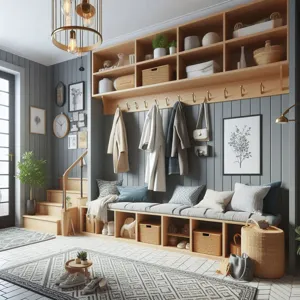
When it comes to transforming your entryway into a stylish and functional mudroom, color schemes and decor choices play a pivotal role in setting the tone for the entire space. The right colors can create a warm, inviting atmosphere while also reflecting your personal style.
**Choose a Cohesive Color Palette**
Start by selecting a cohesive color palette that complements the rest of your home. Soft neutrals such as beige, gray, or white can create a calm and spacious feel, making your mudroom a welcoming transition between the outdoors and your living space. If you prefer a bolder statement, consider incorporating accent colors like deep navy or forest green, which can add depth and character without overwhelming the space.
**Incorporate Textures**
Texture is key to achieving a stylish entryway. Mix and match materials to create visual interest. For instance, pair a sleek, painted bench with rustic wooden hooks or a woven basket for storage. A plush area rug can soften the hard surfaces and add warmth, while a painted accent wall can serve as a stunning backdrop for your decor.
**Add Functional Decor**
Functional decor is the secret ingredient to a successful mudroom. Wall-mounted shelves not only provide a place for decorative items like plants or framed photos but also offer storage for everyday essentials. Consider stylish hooks for coats and bags that align with your chosen color scheme—metallic finishes can add a touch of modern elegance, while wooden hooks can lend a more rustic charm.
**Incorporate Personal Touches**
Don’t forget to infuse your personality into the space. Consider displaying a curated gallery of family photos or artwork that resonates with you. A chalkboard or corkboard can serve as both decor and a practical tool for reminders and notes. Choose planters that suit your aesthetic—succulents for a modern look or hanging ferns for a bohemian vibe—to breathe life into the entryway.
By thoughtfully selecting color schemes and decor elements, you can create a mudroom that not only serves as a functional entry point but also reflects your personal style, welcoming guests with charm and elegance as they step into your home.
6. Smart Storage Solutions: Shelving, Bins, and Hooks
When it comes to creating a functional and stylish mudroom, smart storage solutions are your best friends. A well-organized entryway not only enhances the aesthetic appeal of your home but also serves as a practical space that keeps clutter at bay. By incorporating shelving, bins, and hooks, you can effortlessly transform your mudroom into an efficient area that meets the needs of your family.
**Shelving** is a versatile option that can be tailored to fit any space. Consider installing wall-mounted shelves to maximize vertical space while providing a place for decorative items, shoes, or even baskets for smaller accessories. Open shelving works beautifully for displaying stylish storage bins or seasonal decor, allowing you to switch out items as needed. For a more enclosed look, opt for built-in cabinets that can hide away shoes, bags, and other everyday items, keeping the area tidy and visually appealing.
**Bins** are another essential element for maintaining order in your mudroom. Choose a variety of sizes and styles to accommodate different items—think large bins for bulky winter gear and smaller ones for everyday essentials like gloves, hats, and dog leashes. Labeling these bins can further enhance functionality, ensuring that everyone in the household knows where to find what they need. Stylish wicker or fabric bins can add a touch of charm while serving as practical storage solutions.
**Hooks** provide an easy and accessible way to keep coats, bags, and umbrellas organized. Installing a row of hooks at varying heights can make it easier for everyone in the family—from children to adults—to hang their belongings. To elevate the look of your mudroom, consider decorative hooks that reflect your personal style, whether it’s rustic, modern, or somewhere in between. A chic key holder can also be a practical addition, ensuring that you never misplace your keys again.
By thoughtfully integrating shelving, bins, and hooks into your mudroom design, you can create an entryway that is not only functional but also a reflection of your personal style. With these smart storage solutions, your mudroom can become a welcoming space that seamlessly blends practicality and aesthetic appeal, making a strong first impression every time you enter your home.
7. Flooring Options: Durable and Easy to Clean
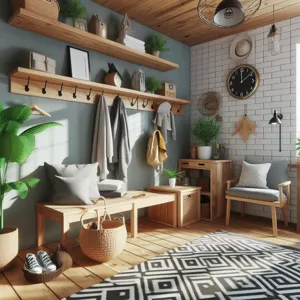
When designing a mudroom, one of the most critical elements to consider is the flooring. This space serves as the transitional zone between the outdoors and your home, which means it’s subject to dirt, moisture, and wear and tear from frequent foot traffic. Therefore, choosing durable and easy-to-clean flooring can make all the difference in maintaining both functionality and aesthetics.
**Vinyl Flooring** is a popular choice for mudrooms due to its resilience and versatility. Available in a plethora of styles and colors, modern vinyl can mimic the look of hardwood or stone while providing water resistance and easy maintenance. Spills and muddy footprints are no match for a quick mop or wipe, making it an excellent option for busy families.
**Tile Flooring** is another fantastic option, especially ceramic or porcelain tiles. Not only are they highly durable and resistant to stains, but they also offer the advantage of being available in various designs, from classic to contemporary. The grout lines may require some upkeep, but the overall durability and ease of cleaning make it a worthwhile investment. Plus, tiles can be heated for added comfort during colder months, enhancing the mudroom’s overall functionality.
For a more natural touch, consider **Luxury Vinyl Plank (LVP)** or **Laminate Flooring**. Both options provide the beauty of natural wood without the susceptibility to warping or scratching. LVP, in particular, is designed to withstand moisture, making it ideal for a mudroom where wet shoes and coats are often the norm.
Lastly, if you’re drawn to a cozy and inviting aesthetic, **Rubber Flooring** could be the perfect fit. Available in vibrant colors and patterns, rubber is slip-resistant and incredibly easy to clean, making it a safe choice for families with children or pets. Additionally, it provides a cushioned surface that’s gentle on your feet, which is a bonus when you’re spending time organizing or waiting in the mudroom.
Ultimately, the right flooring can transform your mudroom into a stylish and functional space that withstands the rigors of daily life. By considering durability and ease of maintenance, you can ensure that your entryway remains both beautiful and practical for years to come.
8. Maximizing Natural Light in Your Mudroom
When it comes to designing a mudroom that feels inviting and functional, maximizing natural light is a game changer. A well-lit space not only enhances the overall aesthetic but also creates a warm atmosphere that makes coming and going a pleasure, especially on dreary days. Here are some strategies to brighten up your mudroom and make the most of the natural light available.
First, consider the placement of windows. If your mudroom is located near an exterior wall, opt for larger windows or even glass doors that allow abundant sunlight to flood in. If feasible, installing skylights can dramatically increase brightness and give your space a more open, airy feel. These overhead windows not only illuminate the area but also provide a unique architectural element that can elevate the entire room.
In addition to window placement, be mindful of window treatments. Heavy drapes can block out precious light, so choose sheer curtains or blinds that can be easily adjusted to let in sunlight while still providing some privacy. Reflective surfaces, such as mirrors or glossy tiles, can further amplify natural light, making the space appear larger and more welcoming.
Using a light color palette on your walls and furnishings can also enhance luminosity. Soft whites, pale grays, or muted pastels can reflect sunlight, creating a bright, cheerful environment. Pair these hues with light wood or white cabinetry for storage solutions that blend seamlessly into your design while still offering function.
Lastly, consider incorporating plants that thrive in bright conditions. Not only do they add a pop of greenery and life to your mudroom, but they also benefit from the abundant natural light, creating a harmonious and inviting entryway. By thoughtfully maximizing natural light in your mudroom, you’ll create a stylish space that welcomes you and your guests with open arms, setting a positive tone for the rest of your home.
9. Incorporating Personal Touches: Artwork and Accessories
Incorporating personal touches through artwork and accessories is a delightful way to infuse character into your mudroom while maintaining its functionality. This space, often overlooked, can transform into a welcoming gateway that reflects your personality and style.
Start by selecting artwork that resonates with you and your family. Whether it’s a bold, colorful piece that energizes the space or a series of framed family photos that evoke warmth and nostalgia, artwork can set the tone for your mudroom. Consider creating a gallery wall that showcases a mix of prints, photographs, and even handmade crafts from your children. This not only adds visual interest but also turns the mudroom into a conversation starter.
Accessories play a crucial role in personalizing your entryway. Think about adding decorative elements that are both stylish and practical. Beautifully designed hooks for hanging coats, vibrant baskets for storing shoes, or even a chic bench where you can sit while tying your laces can enhance functionality while showcasing your unique taste. Incorporate seasonal decor as well—a few pumpkins in the fall or festive wreaths during the holidays can keep your mudroom feeling fresh and inviting throughout the year.
Don’t forget about textural elements! Soft rugs, vibrant cushions on seating, and even potted plants can add warmth and comfort. These touches create a cozy atmosphere that welcomes guests and family alike. By blending practical storage solutions with personal flair, your mudroom will not only serve its purpose but also become a stylish introduction to your home, inviting everyone to step inside with a smile.
10. Seasonal Decor: Keeping It Fresh Throughout the Year
When it comes to transforming your entryway into a functional and stylish mudroom, embracing seasonal decor is a fantastic way to keep the space feeling fresh and inviting year-round. Seasonal decor not only enhances the aesthetic appeal of your mudroom but also adds a touch of warmth and personality that reflects the changing times.
As the seasons shift, consider swapping out elements like rugs, throw pillows, and wall art to reflect the current climate. In the fall, opt for warm tones of burgundy, orange, and gold. You might introduce cozy plaid patterns on a bench cushion or a rustic wreath adorned with faux leaves and mini pumpkins. Transitioning into winter, think about incorporating elements like soft whites and icy blues. A fluffy faux fur throw can add warmth, while a few snowflake decorations can evoke the charm of the season.
Spring invites a burst of color; consider pastel shades and floral accents. Freshen up your mudroom with vibrant green plants or a cheerful floral arrangement that welcomes the new season. Brightly colored baskets can also be introduced to store shoes and accessories, offering both functionality and a pop of color.
Summer is the perfect time to lighten the mood. Swap out heavy fabrics for lighter linens and bright colors. Incorporate beach-themed decor, such as shells or driftwood accents, to create a breezy atmosphere. An airy, light-feeling space can make coming and going feel more relaxed and enjoyable.
By regularly updating your decor to align with the seasons, you not only enhance the visual appeal of your mudroom but also create an environment that resonates with the experiences and feelings associated with each time of year. This thoughtful attention to detail will ensure your entryway remains a welcoming and stylish space, inviting family and guests to step in with a smile, no matter the season.
11. DIY Projects for a Budget-Friendly Mudroom Makeover
Transforming your mudroom into a functional and stylish space doesn’t have to break the bank. With a little creativity and some hands-on effort, you can embark on a variety of DIY projects that will breathe new life into this often-overlooked area of your home. Here are some budget-friendly ideas to help you revamp your mudroom without splurging.
**1. Creative Storage Solutions:** One of the biggest challenges in a mudroom is keeping it organized. Consider building your own storage benches using reclaimed wood or inexpensive plywood. Not only will this provide a place to sit while you take off shoes, but it can also double as storage for boots and bags. Add some baskets or bins to keep smaller items tidy and easily accessible.
**2. Wall Hooks and Racks:** Maximize vertical space by installing wall hooks or a pegboard for coats, hats, and bags. A simple wooden plank with hooks can be a stylish addition and is an easy DIY project that requires minimal tools. You can even personalize it with a fresh coat of paint or a fun stencil to match your decor.
**3. Custom Shelving:** If you have an empty wall or corner, consider building shelves to display decorative items or store everyday essentials. Floating shelves are a trendy and space-saving option that can be made from reclaimed wood or inexpensive shelving boards, giving your mudroom both functionality and flair.
**4. Floor Makeover:** If your mudroom floor is looking worn or outdated, consider painting it for a quick refresh. Use outdoor paint for durability, and create a pattern with painter’s tape for a stylish effect. Alternatively, peel-and-stick vinyl tiles can be an affordable and easy way to add color and texture.
**5. A Fresh Coat of Paint:** Sometimes, all a space needs is a new hue. Choose a color that reflects your style and complements the rest of your home. A bright, cheerful shade can make the mudroom feel more inviting, while a classic neutral can create a clean, sophisticated look.
With these DIY projects, you can effortlessly update your mudroom into a functional and stylish entryway. Not only will you save money, but you’ll also enjoy the satisfaction of creating a space that meets your family’s needs while reflecting your personal style. So roll up your sleeves, gather your supplies, and let your creativity shine!
12. Maintaining a Tidy Mudroom: Daily Habits and Routines
Maintaining a tidy mudroom is essential for ensuring this space remains functional and welcoming, especially as it serves as the first impression of your home. Establishing daily habits and routines can transform your mudroom from a chaotic catch-all to an organized oasis.
Start by designating specific places for each item. Hooks for coats, bins for shoes, and baskets for miscellaneous gear can streamline the clutter. Encourage family members to adopt a “one in, one out” policy—every time someone brings in a new item, they must remove something else to maintain balance and prevent overflow.
Incorporating a quick daily tidying ritual can also work wonders. Set aside five minutes every evening to do a quick sweep of the space. Hang up coats, return stray shoes to their designated spots, and empty out any bags or backpacks that may have accumulated items throughout the day. This small commitment can save you from a larger cleanup down the line.
Consider adding a chore chart for family members, assigning each person specific responsibilities for keeping the mudroom tidy. This not only distributes the workload but also fosters a sense of ownership among everyone in the household.
Finally, make it a point to periodically reassess your mudroom’s organization. Seasonal changes may require a shift in the items stored there, so take the time to purge items that are no longer needed or used. By integrating these daily habits and routines, you’ll ensure your mudroom remains a stylish and functional entryway that sets a positive tone for your home.
13. Case Studies: Inspiring Mudroom Transformations
When it comes to redesigning your mudroom, sometimes the best inspiration comes from real-life transformations. Case studies of stunning mudroom makeovers can not only spark your creativity but also provide practical solutions tailored to various lifestyles and spaces. Here are a few inspiring examples that showcase how thoughtful design can elevate the functionality and aesthetic of this often-overlooked area.
**1. The Family-Friendly Hub**
In a bustling family home, one family turned their cramped, cluttered mudroom into a welcoming hub. By installing built-in benches with hidden storage, they created a space for kids to sit down and remove shoes easily. Bright, colorful hooks were added at varying heights, making it easy for children to hang their backpacks and jackets. To top it off, the walls were painted a cheerful shade of yellow, instantly brightening the space and setting a positive tone for coming and going.
**2. The Elegant Entryway**
For a more sophisticated approach, a couple in a suburban neighborhood opted for a mudroom that exuded elegance. They replaced traditional cabinetry with sleek, custom-built cabinets featuring glass fronts to display decorative items while still maintaining organization. A stunning marble floor adds a touch of luxury, and a chic chandelier brings in a bit of glamour. This mudroom seamlessly blends style with function, proving that even the most practical spaces can reflect personal taste.
**3. The Rustic Retreat**
In a home nestled in the countryside, a rustic mudroom transformation highlighted the charm of natural materials. The owners opted for reclaimed wood for shelving and hooks, combining it with a stone accent wall that echoed the surrounding landscape. A large, vintage trunk serves as both a bench and storage solution, allowing for easy access to outdoor gear. This design not only enhances the functionality of the mudroom but also creates a warm, inviting atmosphere that resonates with the home’s rustic character.
**4. The Minimalist Marvel**
For those who appreciate simplicity, a minimalist mudroom transformation can be incredibly impactful. A young professional revamped her small entryway by eliminating clutter and opting for a clean, monochromatic palette. A simple, sleek bench with integrated storage coupled with wall-mounted hooks keeps everything tidy and organized. The use of mirrors not only creates an illusion of space but also adds a modern touch, making the mudroom feel airy and open.
These case studies illustrate that a mudroom can be much more than just a transition space; it can be a functional and stylish extension of your home. By drawing inspiration from these transformations, you can design a mudroom that not only meets your practical needs but also enhances the overall aesthetic of your entryway. Whether you lean towards family-friendly designs, elegant finishes, rustic elements, or minimalist approaches, there’s a solution out there waiting to elevate your mudroom to new heights.
14. Common Mistakes to Avoid When Designing Your Mudroom
Designing a mudroom is an exciting endeavor, but it can also be fraught with pitfalls if you’re not careful. Avoiding common mistakes can make the difference between a functional space that meets your needs and a chaotic entryway that feels more like a cluttered catch-all. Here are some key missteps to steer clear of as you embark on your mudroom transformation.
**1. Neglecting Storage Solutions:** One of the most significant errors is underestimating the importance of storage. A mudroom is meant to keep your home organized, so be sure to incorporate ample storage options. Consider built-in shelves, hooks for bags and coats, and benches with hidden compartments for shoes. If you skimp on storage, you might find your beautifully designed space quickly overwhelmed by clutter.
**2. Ignoring Traffic Flow:** A mudroom is a high-traffic area, and it’s crucial to think about how people will move through the space. Avoid placing furniture or storage too close to entryways or walkways, which can create bottlenecks and frustration. Ensure there’s enough room for family members to come and go comfortably, especially during peak times like mornings and after school.
**3. Choosing the Wrong Flooring:** Mudrooms are prone to dirt, mud, and moisture, so selecting the right flooring is essential. Avoid materials that stain easily or are difficult to clean. Instead, opt for durable, water-resistant options like tile, vinyl, or sealed hardwood that can withstand the daily wear and tear while looking stylish.
**4. Overlooking Lighting Needs:** Many mudrooms lack natural light, which can make the space feel cramped and uninviting. Ensure you include adequate lighting—both overhead and task lighting—to illuminate the area effectively. A well-lit mudroom not only enhances its functionality but also makes it a more welcoming entry point to your home.
**5. Skipping Personalization:** While functionality is vital, don’t forget to infuse your mudroom with your personal style. Skipping this step can make the space feel sterile and uninviting. Consider incorporating decorative elements like a colorful rug, framed art, or a stylish mirror to create a warm and inviting atmosphere that reflects your personality.
By avoiding these common mistakes, you can create a mudroom that is not only functional but also a stylish introduction to your home. This careful attention to detail will ensure that your entryway serves its purpose beautifully, keeping your space organized while making a lasting impression on every guest who walks through your door.
15. Conclusion: Creating a Welcoming and Practical Entryway
In conclusion, transforming your entryway into a welcoming and practical mudroom is more than just a design endeavor; it’s about enhancing the functionality of your home while creating an inviting atmosphere for family and guests alike. A well-designed mudroom serves as a buffer zone between the outside world and your living space, offering a seamless transition that keeps your home organized and clutter-free.
As you embark on your mudroom makeover, remember to prioritize both style and utility. Incorporate smart storage solutions, such as built-in cubbies, hooks, and benches, to keep shoes, bags, and outerwear neatly arranged. Select materials that are durable and easy to clean, ensuring your entryway can withstand the wear and tear of daily use.
Don’t overlook the aesthetic aspects—choose a color palette and decor that reflect your personal style, creating a warm and inviting space. Consider adding personal touches, like family photos or a decorative mirror, to make the mudroom feel like an integral part of your home.
Ultimately, a well-thought-out entryway can significantly enhance your daily routines while leaving a lasting impression on visitors. By blending functionality with stylish design, you can create a mudroom that not only meets your practical needs but also serves as a beautiful introduction to your home. Embrace the journey of transformation, and enjoy the countless benefits of a welcoming and practical entryway for years to come.
In conclusion, transforming your entryway into a functional and stylish mudroom can completely redefine the first impression of your home while providing a practical space for daily life. By incorporating thoughtful organization, clever design elements, and personal touches, you can create a welcoming environment that blends seamlessly with your decor. Whether you’re looking to streamline your family’s busy routines or simply elevate your home’s aesthetic, these tips will guide you in crafting a mudroom that meets your needs. So roll up your sleeves and get started on this exciting project—your stylish and efficient entryway awaits! Don’t forget to share your before-and-after photos with us; we’d love to celebrate your transformation!

